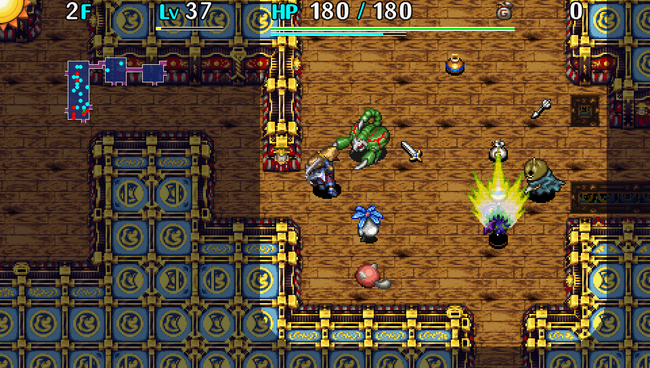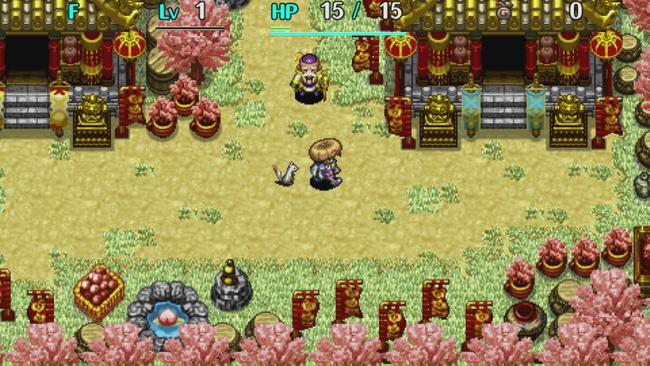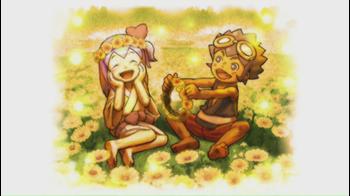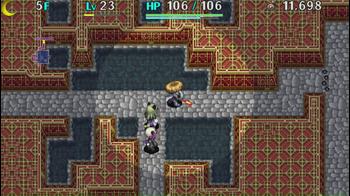
Shiren The Wanderer: The Tower of Fortune and the Dice of Fate - Review
The Shiren the Wanderer series has had a spotty history of localization over its lifetime, not to mention a somewhat complex history in general. Shiren is a part of the larger Mystery Dungeon series, which originally worked as a spin-off to Dragon Quest. Mystery Dungeon has also been further spun off featuring several other franchises as well, notably Pokémon, Chocobo's Dungeon, and last year's Etrian Mystery Dungeon. It can be a little confusing.
Of the main Shiren series, only two titles had previously received official English localizations: the 2006 Nintendo DS remake of the first Shiren Super Famicon game, and Shiren the Wanderer 3 on Nintendo Wii, originally released in 2008.
That brings us to Shiren The Wanderer: The Tower of Fortune and the Dice of Fate. This title actually originally released on Nintendo DS in 2010, known as Shiren the Wanderer 5 in Japan. The game received an enhanced port for PlayStation Vita last year, and Aksys Games decided to give the series another localized entry with this one. Luckily, Shiren games are not especially story focused and each stands on its own, so you don't have to be familiar with the series to jump in here.
The narrative of Shiren 5 is fairly basic in scope. Shiren and his talking ferret companion, Koppa, happen onto the small but peaceful Inori village. Here, they learn of the plight of Oyu, a young woman who has been stricken with an incurable disease. Within a few days, she is expected to pass on from this world.
In order to save Oyu, her sweetheart, Jirokichi, vows to climb the Tower of Fortune to meet with the God of Fate, Reeva. Shiren takes the journey with him.
Shiren the Wanderer is a roguelike RPG in the Mystery Dungeon mold. This means the player controls Shiren in a turn-based fashion on a grid through randomly-generated dungeon floors. The sprite art-style used is as fantastic as it is nostalgic. The colors especially look great on the OLED Vita screen, and the spritework scales quite well when played on a PlayStation TV. It is, without a doubt, one of the best looking games on the system.
Most of the main game takes place in a linear sequence of tower floors. The goal is to collect items and equipment to survive in the tower, find the staircase to the next floor, and repeat until you get to the top. Collapse in the tower, however, and you'll be brought back the the base village at level 1, losing all your items.
Of course, there are several systems in place to make dungeon traversal a bit more lenient on the player. Shiren can use an Escape Scroll to leave the tower with his items/equipment intact, and Undo Grass allows Shiren to escape when brought to the brink of his HP meter. Further, Shiren can purchase Tags to place on his equipment, so that if they are ever lost in a dungeon, they can be brought to the Lost & Found. Shiren can also place money and items in the storage for safe keeping. However, Shiren's level will always reset when he leaves the dungeon.
Shiren can also recruit several various allies to join on the quest up the tower. There's Tao the tower guide, who wears a panda hat and charges money each time she joins the party. Kojirouta is a rich samurai who throws money at monsters. Okon and Kohaku are fox sisters who can transform into enemies or even equipment for Shiren. Additionally, these companions also gain levels as they progress through the tower, and their levels never reset, even if they lose all their HP.
It's worth noting that while allies are automatically controlled, they do have slight quirks in their dungeon behavior. Kojirouta, for example, will always charge towards a foe, while Tao tends to stick closer to Shiren.

One key element to games like Shiren the Wanderer tends to be a sense of "randomness". Of course, the floor layouts and monster spawns are randomly generated, but there so many other things that can fall into that description. Numerous and various types of traps litter the floors: some might make Shiren blind for a moment, some might force him to trip and drop some items, others might simply explode in his face.
The loot that Shiren finds is never certain either, and with limited inventory space, delegating what to leave, what to take, how to to organize your loot is something the player constantly has to manage. Shiren has to manage both his health as well as his hunger, so keeping healing items and food items in the inventory is critical. There are also dozens of various scrolls & charms that Shiren can collect which can significantly impact his time in the tower. Scrolls can remove traps, upgrade a weapon, deal damage, and force status effects. There are tons of items to find and each finds a use in the adventure.
Each floor may also include a fellow wanderer - anything from a blacksmith to upgrade weapons to a young man asking for some money. Even shop inventories change each time you visit. Simply put, there's a lot to find in the dungeon, and you never know what exactly it's going to be.
The level of randomness keeps things interesting, as you'll be retreading through floors more than a few times to gather items and upgrade your equipment.
It can also be the source of frustration: you never know when you'll stumble onto a Monster Room, full of baddies and traps and you have no choice but to halt your progress and retreat lest you get killed. Sometimes you'll have lucky streaks where you find all the right items you were looking for, and at other times you just gotta roll with the punches - it's all part of the package.
There are so many small but significant factors embedded in Shiren's gameplay mechanics, which makes it somewhat tricky to mention everything. It's impressive how well the many elements synergize to create a rich, cohesive game.
Katanas and shields can be fused together to place various beneficial effects on weapons. These effects can include increasing damage output to a certain type of monster, or reducing the rate at which Shiren gets hungry. On top of that, certain katana/shield combinations can "resonate" for additional effect, such as increasing damage even further or allowing Shiren to wear a second accessory.
Several dungeons also have a day/night system, in which nocturnal enemies are impervious to Shiren's katana. When night falls, he must rely on using special abilities to vanquish the more dangerous nighttime creatures. These abilities encompass various types and magical attacks as well as protective buffs.
However, each ability can only be used once per floor, so knowing when to flee and when to attack is crucial. Further, the arsenal of abilities acquired, much like most of the game, has an element of randomness to it. Sometimes you might encounter a wandering ability master who will teach Shiren another trick, sometimes he can learn them on his own at night.
Nighttime also limits Shiren's visibility, such that he must use a torch to light his path. This allows him to see his surroundings better, but also makes him a larger target for enemies. Torches also are only usable for a limited time so it's best to carry several at all times. Additionally, scrolls cannot be read without light, which can make traversing at night even trickier.
Shiren is not an especially easy game. It's not too difficult to be truly unfair, but the level of challenge is high enough that making way to the top of the Tower of Fortune really feels like an accomplishment. Players will find plenty of roadblocks on the way, but the game always leaves enough there so you never feel totally helpless.
Unfortunately the game's boss encounters are pretty lackluster. Few in number, and each boils down to a swarm of enemies surrounding Shiren with a high HP leader thrown into the mix. The encounters are still fairly difficult and rewarding to overcome, but it's a bit disappointing there wasn't something a little different in place there.

The main game revolving around the Tower of Fortune itself is a little bit disappointingly linear and a bit on the short side at around 20 hours in length. The various floors of the tower also lack a little in aesthetic variety. However, that is really only scratching the surface of what Shiren 5 has to offer. Numerous post-game dungeons can be found, many with gimmicks or limitations to create interesting challenges for the player. A few dungeons require some sidequesting to unlock, such as escorting Kojirouta safely to the top of the Tower of Fortune (which is trickier than it may seem considering his tendency to rush towards his death).
Other dungeons were added to the Vita port, and are available through an NPC found in the village. Some dungeons allow Shiren to bring his high level equipment with (trust me, you'll need it), while others force him to start from a clean slate. Dungeon gimmicks also vary from Shiren quickly getting hungry, to floors with strict step-count limits, to dungeons not allowing Shiren to level up at all. There's plenty of interesting challenges to be found in the post-game and they can keep the player occupied for a long time. The true test doesn't start until after the credits roll.
All in all, Shiren The Wanderer: The Tower of Fortune and the Dice of Fate is an exceptional and mechanically dense roguelike filled with many small pieces that fit together especially well. The synergy between the many various gameplay elements is remarkable and makes a very compelling package. It keeps the player on their toes, both due to a moderate sense of challenge and also never knowing what's around the corner - true to the name 'Mystery Dungeon'.


